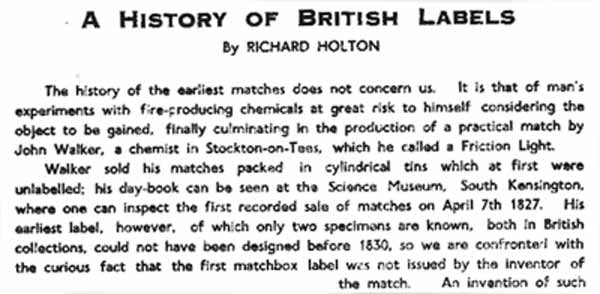History of British Labels
By Richard Holton
An abstract from the article in "The Matchbox Label" magazine, v.1, ¹ 1, 1958
The history of the earliest matches does not concern us. It is that of man's experiments with fire-producing chemicals at great risk to himself considering the object to be gained, finally culminating in the production of a practical match by John Walker, a chemist in Stockton-on-Tees, which he called a Friction Light.
Walker sold his matches packed in cylindrical tins (fig. 1) which at first were unlabelled; his day-book can be seen at the Science Museum, South Kensington, where one can inspect the first recorded sale of matches on April 7th 1827. His earliest label (fig 2), however, of which only two specimens are known, both in British collections, could not have been designed before 1830, so we are confronted with the curious fact that the first matchbox label was not issued by the inventor of the match. An invention of such a sensational nature as a tipped wooden splint capable of being ignited by rubbing left the tinder box little chance of survival except in remote country districts and among the poorest people who could ill afford the price of matches but continued to strike the flint against the steel.
 Partial photocopy of the fragment
Partial photocopy of the fragment
|
The news must have travelled fast, for very soon after their introduction matches were being made by other chemists, thus establishing the back-parlour industry that was destined to grow in step with the demand for matches, or "lucifers", as they were generally called. Each chemist had his own label, letter-pressed in more or less plain type, with or without a border, and of convenient dimensions for sticking on to the top of a box roughly the size of a Swan Vestas box but with a lift-off lid. The earliest known specimen, modestly described in the Bryant & May Museum Catalogue as "very rare, possibly unique", was made by Samuel Jones, owner of a flourishing business specialising in fire-making contrivances and situated in the Strand, London (Fig. 3). The date of the box has been computed as 1829; its value has never been determined. Mr Jones, "Inventor of the Prometheans, Self-acting Coffee Pot, Etnas, etc." describes the process by which his lucifers can be ignited. The label belongs to the class known as "top" labels.


